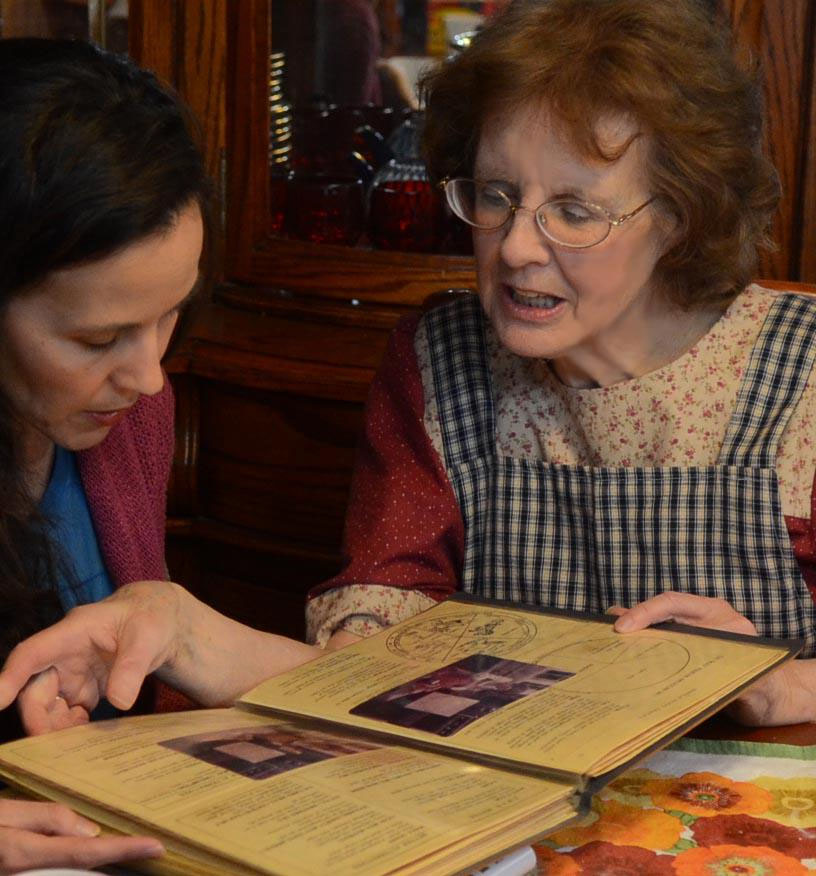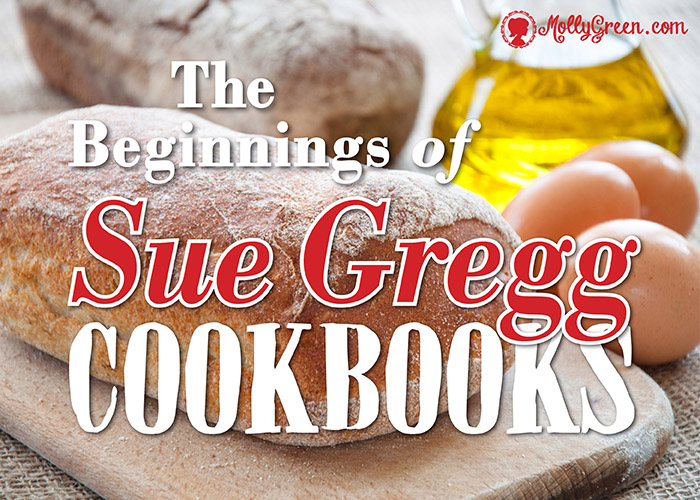By Sue Gregg
The Beginning
For years my idea of breakfast was standard American fare: scrambled eggs and bacon with white bread toast, a glass of orange juice, or boxed cereal for dad and the kids, a cup of coffee for mom. For dinner, real-man stuffing, kid-pleasing meat and potatoes, frozen peas or corn or other canned vegetables, iceberg and tomato tossed salad or Jell-O on top of crisp iceberg lettuce, and ice cream for dessert.
My oldest son suffered from severe headaches. Colds and the flu ran their regular courses through the family. The toddler’s sniffles continued even after a ten-day regime of antibiotics. Dad’s craving for chocolate and cola drinks induced an alarming weight gain. Job pressures brought irritability and depression that strained family relationships.
Asking Questions
I began to research articles and books to find answers. Sugar? A nutrient-depleted thief. White flour? Lost its fiber. Processed foods? Overcooked with cosmetic colorings and added flavors. I read everything about nutrition I could find. Contradictions were often confusing. Nutritionists seldom seemed to agree.
The fear of heart disease, diabetes, cancer, and other degenerative diseases wasn’t a very positive motivator either. Neither were nutritionists who threatened with negatives: no salt, no eggs, no cheese, no dairy products, no cholesterol, no gluten. No, No, No! What was there left to eat?
Eventually, I distinguished the controversial peripherals from the basics. For my family it meant switching from refined flours to whole grains and from processed fats to olive oil, butter, and coconut oil. It meant decreasing refined products and increasing fresh whole foods. How could I introduce these changes to our family?
My Experiment Begins
My family began to read labels. My eldest daughter scoured the cupboards for questionable packaged foods with refined flour and sugar and long lists of unpronounceable chemicals. She put the culprit packages in a corner cupboard and tied a string around the handles.
I don’t recommend the “cold turkey” approach to others. The shock can defeat all good intentions! Empty cupboards are not exciting resources for dietary improvement. That, however, was not my biggest challenge. I had set myself up for failure by following a cookbook that introduced “healthy” recipes to my family that seemed very strange to them. I hadn’t counted on their resistance to the shock of the unfamiliar.
For my husband growing up on a farm in Washington State, grain milling meant grinding corn, wheat, barley, or oats only for cattle feed. That concept was about to change. I found a lady who agreed to come to my home and demonstrate not only the milling, but also bread making. So my husband volunteered to take the children out for the evening and leave me with the checkbook. Three hours later they returned to see a mill, a bread kneader, and a dehydrator on the kitchen counter and a pleased sales lady leaving with a $700 check. I knew I was committed to making this equipment work for us.
Whole grain pancakes, dinner rolls fresh out of the oven, braided Parmesan loaves and pancakes—what a dream! Cinnamon rolls sweetened with honey, imbedded with walnuts and raisins became special favorites. Our older son’s curiosity about the whole process was piqued, too. Friends heard that I was baking, and they asked me to show them how. We baked together. Then they bought their own equipment. When that happened for the third or fourth time my husband observed, “You know,” he said. “You are ‘selling’ those machines.” After I responded with a long silence, he added, “You ought to get credit for the sales.”
I knew what he was asking me to do. Pondering his request I shed not a few tears of resistance.
Hours later I said with resignation, “Ok, I’ll do it.” So we began to set up appointments. As we demonstrated, people began to ask questions that I couldn’t answer. Being a researcher at heart I dug for the answers and incorporated what I was discovering about nutrition and baking techniques into my demonstration presentations.
I was now in my element—researching and teaching. So my husband and I set up all-day Saturday workshops for groups that expanded the presentations beyond bread baking. It wasn’t long before a participant voiced a request: “Do you have recipes?” The answer was “Yes.” So I collected a hundred of them and printed them out on 3×5 cards without considering that this could lead to something more, such as cookbook publishing. Where this all led in fulfilling the “far greater effect than we could ever imagine” was to come years later.
Discovering the Design
The Bible does address the subject of food. In Genesis the personal, transcendent, communicating Creator breathed life into the human body. He provided food as the first gift to the first couple. As the Original Nutritionist He structured proteins, fats, carbohydrates, vitamins, minerals, fiber, RNA, DNA, and the still-undiscovered nutrients essential to life.
The problem with food became clearer to me. Perhaps we’ve deceived ourselves. We’ve devised a lot of products that look, taste, and fill like real foods. We’ve developed “fake sugars,” saccharin, cyclamates, and aspartame.
Our bodies, however, have been designed for real God-given appetite-appealing food. A blessing!
Managing the earth’s resources (taking “dominion” Genesis says) is our responsibility. This command suggested a plan for change. I needed a design for incorporating whole food alternatives into our menus. Since God also created taste buds to enjoy what He created, my family shouldn’t have to endure dishes that tasted like paper plates. And that was the obstacle I had stumbled into. So I set aside a failed experiment.
Recipes are the Key
Almost two years later I was looking out the window over the kitchen sink, “God, there must be a way …” when an idea passed through my mind. Why didn’t I take familiar, well-received recipes and start tweaking them by substituting healthier ingredients? Perhaps I could begin by substituting half whole grain flour into baking recipes. Surprisingly, that helped transition my family to healthier eating. They needed a bridge from the familiar to the unfamiliar.
For my family the key to better eating was developing new recipes that met my family’s taste-test approval. I took a favorite family muffin recipe and gradually, experimenting over several months, changed the white flour to whole grain, the sugar to honey, and omitted the hydrogenated fat altogether. Those conversions moved us into a new world of wholesome, nutrient-dense foods.
As I tested new recipes, my husband proposed that we give each member of the family opportunity to express a response to its taste and appeal. Is it a “Please let us have this one once a week!” winner, or does it need some improvements, perhaps in texture or spicing? A real loser? Don’t blame the cook. We can set an experimental recipe aside and develop another one.
Children have a natural curiosity about food preparation. Our son’s interest, captured by a grain mill and breadmaker we had purchased, developed into a love for baking. Our oldest daughter’s interest in other cultures and languages introduced us to Japanese cookery and to international students as guests in our home. Our youngest daughter’s desire for neatness and order developed into management skills in menu planning and shopping. Dad even started fixing a family favorite—Whole Grain Waffles—from scratch.
Our Family Benefits
It took time to develop new recipes and adjust to new menu patterns. Changes in how we felt—some subtle, others dramatic—encouraged us. Our oldest son found that it was sugar that induced his headaches. Some people do discover that certain foods trigger bothersome allergic reactions. Trips to the doctor for the sniffles ceased.
We sometimes still get a touch of the current “bug.” But no longer does it run a devastating course through the entire family. Could it be that our immune systems are becoming better fortified? Dad’s weight moderated. Best of all, his more lovable disposition returned. Do addictions to chocolate, colas, and candy for an energy boost affect the mind and emotions too?
What can a family gain by serving quality foods in a nurturing environment? First, good food avoids the obvious negatives of a depleted diet. Second, a steady supply of the best nutritional sources we can find support the mind, body, and spirit. Finally, by searching out the Creator’s design instead of following the latest advertising fad we express faith. God honors that.
Research studies provide ample evidence for the benefits of wise food choices. The real challenge is not the “why” of healthier food. It is the “how to” that stops most people. That is why I specialize in creating recipes with a broad appetite appeal that are really doable. My husband and I are committed to helping others overcome obstacles to better eating.
When I serve my guests I don’t give them a “this is healthy for you lecture” to motivate with fear or guilt. Instead I wait for their evaluation that echoes the Creator’s Genesis pronouncement as 
Sue Gregg, author of the Sue Gregg Cookbooks, and her husband, Rich, of 54 years are grandparents to six homeschooled children and two public schooled valedictorians. They welcome young adults for apprenticeship training in their Southern California home where they model cooking skills, hospitality, and mission vision. For more information, visit www.suegregg.com, or www.facebook.com/sue.gregg.cookbook







Now see, God does listen!
Just this week, I’ve decided that I must change what I prepare and serve for our family. I was super-healthy before and after our first was born, but a second pregnancy and baby (Irish twins) took it’s toll on my energy, sleep, time not to mention flaring my autoimmune issues.
My children have been getting sick a lot lately. Myself, too. I’m drinking 2-3 cokes a day (hate coffee/tea) and craving refined sugar. Two toddlers, one that will most things the other that seems to hate all veggies and fruit (I’m sure texture issue) and a hubby with similar issues as the author’s. I prayed this week about what to do. I started looking at cookbooks but then there’s the dreaded cold turkey and complete 180 from what we’re used to. This article inspired slow change and to purchase her book. I’ll research too.
Just yesterday I was thinking about God’s nutritional plan and His plan in general. That companies like Coke take a public and political stand to support anti-Christian ideas and lifestyles and I’m giving them my money. Their products make the body sick, teeth decay, moods swing and they openly fight against my family’s value. I talk about living God’s plan and living in the world but not being of it. I’m challenging myself to feed my family according to His plan and to not support companies that seek to interfere with that at a minimum and at best, not support companies that defy God, period.
Glad this article blessed you, Julia! Thanks for reading!
–Molly Green Staff